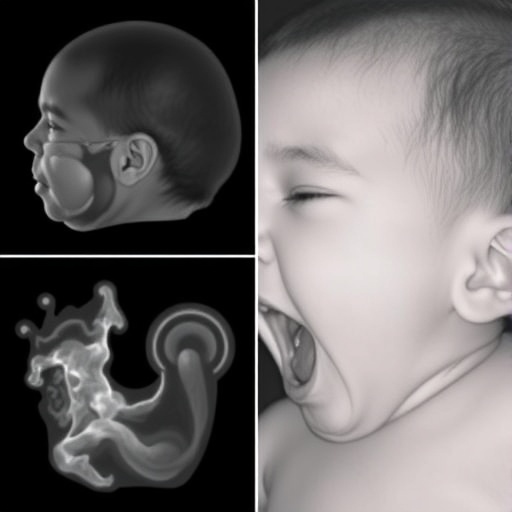In recent years, advancements in artificial intelligence and machine learning have permeated various fields, including healthcare, education, and social sciences. One intriguing development that has emerged in the intersection of technology and pediatric care is the automated analysis of infant cries. Research led by Qian Cao, Min Huang, and Xiang Zhu, among others, has highlighted the remarkable potential of integrating sophisticated algorithms to decode the subtle nuances embedded in an infant’s cry, a crucial form of communication for newborns.
Infant cries are often viewed merely as expressions of discomfort or distress, but they can convey a wealth of information about a baby’s needs. Understanding these cries can significantly improve caregiving practices, as parents and caregivers can respond more effectively to the infant’s emotional and physiological states. For instance, differentiating between a cry caused by hunger versus one stemming from fatigue can lead to more informed feeding and sleeping practices.
Cao and his colleagues focused their study on developing and validating an automated time label segmentation method that precisely analyzes undulating cry patterns. This technique leverages advanced signal processing algorithms to distinguish various cry types based on pitch, duration, and rhythmic characteristics. Such a method emphasizes the shift toward evidence-based practices in pediatrics, with potential tenets rooted in the science of sound and the art of caregiving.
The study is groundbreaking not only because it applies cutting-edge technology to infant care but also due to its interdisciplinary approach. Researchers created a comprehensive dataset of recorded infant cries, allowing the algorithm to learn from a multitude of examples. By feeding the system with diverse data, ranging from cries of infants expressing discomfort to those indicative of joy or playfulness, they trained the algorithm to recognize subtle variances in sound frequencies and durations.
Although the initial idea might seem straightforward, the implementation of the segmentation method poses significant challenges. Identifying and isolating specific cry segments amidst environmental noise or overlapping vocalizations demands meticulous attention to detail and advanced audio filtering capabilities. The researchers devised a robust framework capable of addressing these challenges, significantly enhancing the reliability of their analyses.
One of the most compelling aspects of this research is its potential to empower parents. Today’s parents are inundated with parenting advice, and amid this ocean of information, the ability to accurately interpret an infant’s cry could be revolutionary. Imagine a scenario where a caregiver utilizes a smartphone app that employs this automated segmentation method to discern why a baby is crying. Such an innovation could offer real-time feedback, fostering a deeper bond and understanding between caregiver and infant.
Furthermore, the implications extend well beyond individual households. Hospitals and pediatric care facilities might soon harness such technology to better cater to the needs of their youngest patients. The ability to track crying patterns and correlate them with physical health parameters could lead to early interventions and ultimately improve outcomes for newborns facing health challenges.
Technical rigor aside, the ethical considerations surrounding the use of such technology in pediatric care cannot be understated. The researchers have emphasized the importance of safeguarding confidentiality and ensuring that parental consent is prioritized whenever data is collected or analyzed. Establishing clear guidelines for the deployment of automated systems in sensitive environments like pediatric care is crucial to maintaining trust and transparency with families.
The reception from the scientific community has been cautiously optimistic. While many acknowledge the technological feats achieved in this research, questions concerning the algorithm’s accuracy and its effectiveness across diverse populations are still prevalent. Ongoing assessments and peer reviews will be essential as the research community weighs the benefits of such technology against potential pitfalls.
As research in this area progresses, collaboration will be key. Pediatricians, engineers, and data scientists must continue to engage in dialogues that enable holistic development and implementation of cry analysis tools. Each sector brings unique insights that can enrich the technology, ultimately leading to a more compassionate and effective approach to infant care.
Moreover, parental education must evolve alongside these technological advances. As caregivers gain access to more tools designed to assist them, it will be vital to ensure they are equipped with the knowledge and support necessary to use such technology effectively. Proper training programs could accompany the deployment of automated systems, promoting the correct interpretation of data and instilling confidence in new parents.
In conclusion, the research led by Cao, Huang, and Zhu paves the way for a new era in how we understand and respond to infant communication. The automated time label segmentation method for analyzing infant cries is a prime example of how technology can bridge the gap between traditional caregiving and modern science. As this field continues to grow, we can anticipate enhanced interactions between parents and their children, providing the foundation for healthier and happier developmental experiences. With each cry decoded and understood, we move closer to a future where every infant’s needs are met with precision, compassion, and expertise.
Subject of Research: Automated Time Label Segmentation Method for Analyzing Infant Cries
Article Title: Correction: Construction and validation of an automated time label segmentation method for infant cries.
Article References:
Cao, Q., Huang, M., Zhu, X. et al. Correction: Construction and validation of an automated time label segmentation method for infant cries.
BMC Pediatr 25, 825 (2025). https://doi.org/10.1186/s12887-025-06287-z
Image Credits: AI Generated
DOI: 10.1186/s12887-025-06287-z
Keywords: infant cries, automated analysis, machine learning, pediatric care, sound processing, technology in healthcare.




